I have been sending photos to competitions for several years – I started rather occasionally, but now I do it regularly and I use a bit more systematic approach. I decided to share some tips other photographers may find useful.

(Nikon D810 + AF-S Nikkor 300mm f/2.8G IF-ED VR II at 300 mm, f/8, 1/320 s, ISO 640)
Tip no. 1: read contest rules carefully
Many wildlife photography contests use similar rules but some details may be different. Because you will likely pay some fee for participating in the competition, it would be a shame to get your photo disqualified because you missed some important condition. I recommend you to check especially these requirements:
- conditions of making the photo – I believe that most if not all wildlife competitions require photographers to behave ethically when capturing wild nature and animals, but some rules may be different. Baiting may be prohibited completely in one competition, while using food or recorded voices may be allowed in other for example (and it may be mandatory to state it in photo description). Use of live bait is mostly forbidden and even if it is not explicitly mentioned in rules, you should never use it and even think about such possibility.
- date photo was made – some contests accept only works made during a specified period, typically after previous year up to the deadline of this year
- allowed level of postprocessing – I don’t know how it works in other genres but wildlife contests typically accept minor modifications only. Removing or adding objects into the photo is not allowed largely and sometimes it is not even allowed to merging multiple shots (including panoramas and HDR). I always check if I did retouch something in the photo before submitting to contest – I am not a purist who never removes a leaf or a branch in the post, but if I did it, I always submit the version without such retouch
- requirements of image size and format – while you mostly upload a smaller version of images initially, later, if you will succeed, photos would be printed in quite a large size and if they don’t meet requirements for large size print, they could be disqualified later. If your image is extensively cropped or is not good enough for large print, consider to not submit it. Don’t forget, that you will need to send full res photo and even RAW later, so all quality issues will become prominent.
- rules for photos participating in other contests – some contests reject photos, which succeeded in other contests before. It is understandable, that they want to present unique photos and not well-known ones.
Apart from these requirements, you should carefully choose categories for your photos (some contests doesn’t allow later change) and truthfully fill all mandatory fields including descriptions.
Tip no. 2: apply as many photos as allowed
If contest rules allow you to submit more photos, do it. You don’t know what will catch jury attention and it is possible that your most beloved photo will fall and another one will succeed. Of course, I suppose that you are reasonable enough to evaluate the quality of your photos, but if you have enough good images, submit them.

(Fujifilm X-T2 + XF100-400mmF4.5-5.6 R LM OIS WR + 1.4x at 560 mm, f/8, 1/10 s, ISO 5000)
Tip no. 3: save submitted photos for later use
I recommend creating a folder with submitted photos for every contest you participate. It is good for quick overview and if you use something like Lightroom o Capture One, you can use a virtual collection for every competition. But I strongly recommend you to keep full size processed images too. As I said earlier, if your photos will qualify to second or final round, you will need them and in non-destructive editors like Lightroom or Capture One it can easily happen that you slightly modify image meantime (I often do some more final touches to photo when preparing for contests) and then you may not be able to send exactly same image in full res. Judges won’t probably be happy when the full-size image will differ from one submitted earlier. Keep 16bit AdobeRGB TIFFs and you can be sure that you will be able to fulfill any future requirements from the contest organizer. I store these files outside of my Capture One catalog because I use it only for the given contest.
Tip no. 4: save photo names and descriptions for later
I found useful to keep photo names and descriptions for later use. It may need to put a lot of effort to create quality descriptions (especially if you are not a native English speaker and you participate in the international competition :) and if you will submit the same photo to more contests, possibility to reuse existing descriptions may save you time. Sometimes you will need detailed descriptions when your photo will qualify to the second round and meantime you will probably forget, what you entered in application to other contests. So my advice is to write descriptions in advance and keep them either in photo metadata (if you are sure that you won’t modify text for other contest) or in a separate file (Excel, Google Docs, text file). It will allow you to reuse descriptions in future – when I didn’t it, I regretted it.
Tip no. 5: don’t wait with your application for last minute
If you tend to do things at the last minute (like me :), think about things which could slow you down. Maybe the contest website will stop work under requests of other last-minute participants :), maybe you will be forced to fill a long, comprehensive application form. Don’t forget different time zones which may cause the registration period will end earlier than you will expect.

(Fujifilm X-T3 + XF200mmF2 R LM OIS WR + 1.4x F2 at 280 mm, f/3.2, 1/280 s, ISO 160)
Tip no. 6: enter contest dates into a calendar or todo list
If you decide to apply contests on regular bases in future, enter their deadlines (with some time for preparation) into a calendar or to-do list with repeating for next years. Some contests slightly change deadlines between years, so it is better to check them in advance. I manage my tasks in Todoist so I use it for keeping eye on contests too. If you are on Todoist too, you can import my template.
List of contests I participate in
I compiled a list of contests which I consider interesting and maybe other photographers find it useful. Here it is (we can expect similar deadlines in future years too):
- Asferico – deadline on December 2nd, 2018
- International Wildbird Photo Competition – deadline on December 2nd, 2018
- Oasis Photo Contest – early-bird registration with lower entry fee was available before December 15th in last years, but it is not opened yet this year
- Wildlife Photographer of the Year – probably most prestigious contest’s deadline is on December 13th, 2018
- Siena International Photo Award – not solely wildlife but the prestigious contest with early-bird registration ending on December 24th, 2018 and deadline on January 31st, 2019
- Wildlife Photography Competition was established by successful wildlife photographer Will Burrard-Lucas – if you pay an entry fee, you can participate in all three categories until December 31st, 2018
- Nature’s Best Photography – Windland Smith Rice International Awards – another prestigious competition originated in the USA has the deadline on January 18th, 2019
- Big Picture – deadline on January 3rd, 2019
So pick your best photos and go for it :)
And to keep all those tasks in order, I recommend using a task management tool :) Try kanbantool.com , it’s has a free plan that should be enough for that purpose and it’s really good.